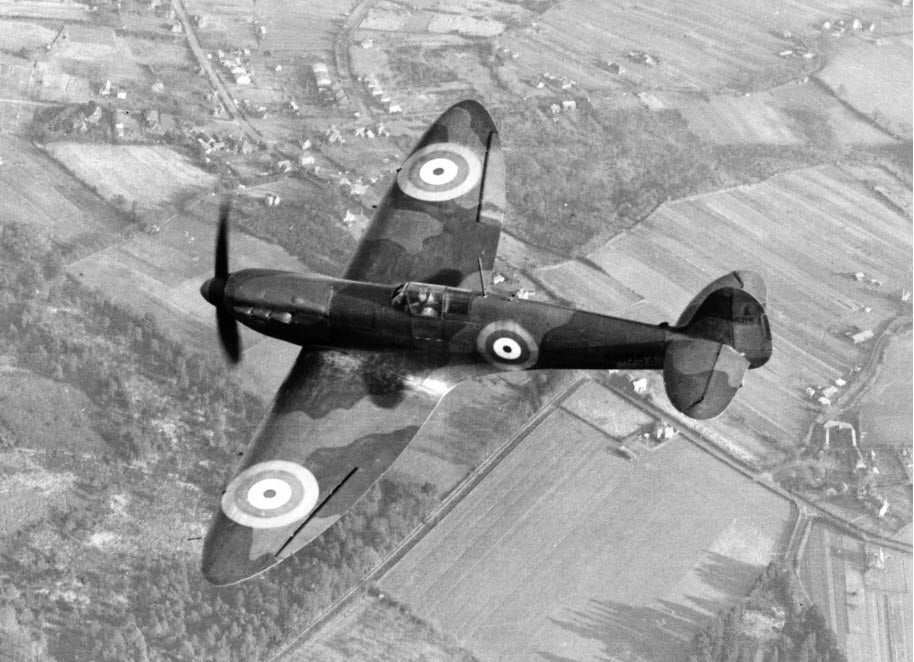How To Exit An Aircraft Quickly
Until the closing days of the Second World War the only way to exit a fatally damaged aircraft was to jump through a door or hole, or after removing the canopy to roll the aircraft upside down and gracefully "fall out".
Then, by the Grace of God, if your parachute opened and you didn't collide with a hard object upon landing, one might survive such an event.
But as the Second World War was ending everyone was building jet-powered aircraft which made exiting the aircraft in an emergency very difficult, at best.
Enter Bernard I. Lynch, B.E.M. (British Empire Medal), a ground fitter for the Martin-Baker Aircraft Co., Ltd.

Bernard I. Lunch, B.E.M. seated in the cockpit of an aircraft fitted with the Martin-Baker MK1 ejection seat.
He developed the Martin-Baker MK1 ejection seat for these modern, jet-powered aircraft.
The "Flying Wing"
There was considerable interest in developing a "Flying Wing" aircraft as illustrated in this poster below:

The Shape of Things to Come.
The Armstrong Whitworth A.W.52 flying wing aircraft was an all-metal, experimental two-place aircraft with tricycle landing gear which could be retracted in flight.
The aircraft was 37 feet 4 inches in length and had a wingspan of 90 feet with a height of 14 feet 4 inches.
The airplane incorporated boundry layer control to delay the wing stalling in the area of the ailerons, and used engine heat for the leading edge of the wings for deicing.
It's empty weight was 19,662 pound and a gross weight of 32,700 pounds.
Maximum speed at Sea Level was a respectable 500 mph and 480 mph at 36,000 feet. Maximum range was 1,500 miles flying at 330 mph at 36,000 feet.
The Armstrong Whitworth A.W.52 aircraft was in the development and test flight stage of development when test pilot John Oliver Lancaster, D.F.C. was tasked for a test flight on 30 May 1949.
Installed in this aircraft was the new Martin-Baker MK1 ejection seat.

Test Pilot John Oliver Lancaster, D.F.C. in the cockpit of an aircraft.
During this test flight, Lancaster encountered severe pitch oscillations in a 320 mph dive. Lancaster feared that the aircraft would disintegrate, so in the very first use of a Martin-Baker MK1 ejection seat Lancaster exited the out-of-control aircraft.
Lancaster fired the seat and was quickly thrown up, out, and clear of the aircraft. He then parachuted to the ground safely and without injury.
Meanwhile, the aircraft he was flying was completely destroyed.
The Martin-Baker MK1
The ejection seat is launched with a two-cartridge ejection gun to an initial velocity of 60 feet per second.
After rising 24 feet above the aircraft, a static line fired a drogue gun, deploying a 24-inch drogue parachute to stabilize the seat. The static line also actuated the seat's oxygen supply.
When stabilized the pilot would then release himself from the seat and open his parachute by pulling on the rip cord.

The Martin-Baker MK1 aircraft ejection seat.
Martin-Baker Aircraft Co., Ltd. advertised their new ejection seat around the world.

The caption reads"It was effectively demonstrated when Lft. Lt. J.O. Lancaster, on May 30th, 1949, saved his life by using this Ejector Seat under extreme conditions.
As of May 31, 2023, 7,695 pilots worldwide have been saved by Martin-Baker ejection seats. Of them, 69 used the MK1 ejection seat.
Until next time, keep your eyes safe and focused on what's ahead of you, Hersch!
I hope you enjoyed this trip through some of the history of aviation. If you enjoyed this trip, and are new to this newsletter, sign up to receive your own weekly newsletter here: Subscribe here!







Leave a comment
This site is protected by hCaptcha and the hCaptcha Privacy Policy and Terms of Service apply.